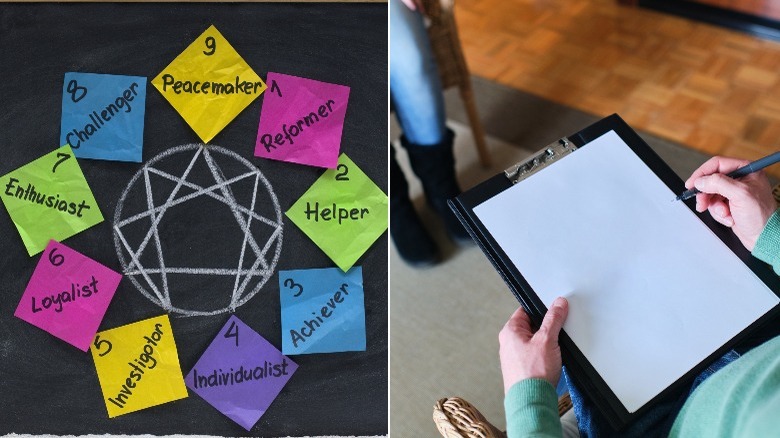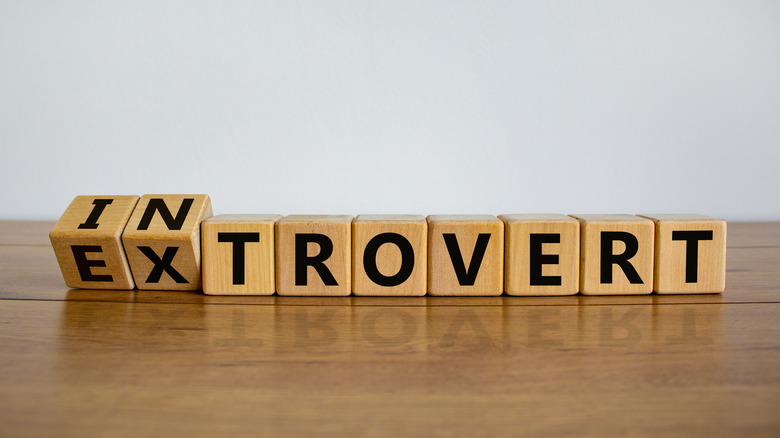If You're An Enneagram 5, This Is The Number You're Most Compatible With
The Enneagram is a personality typing system — like Meyer's Briggs and StrengthsFinder — that is quickly gaining popularity. However, the Enneagram has enjoyed a rich history in spiritual traditions and its visual depiction is derived from the ancient symbols and the mathematics of Pythagoras, per the Enneagram Institute. It breaks down into nine personality types, with trajectories between them for growth and stress responses. It is also split into thirds by shared traits — located in the Instinctive Center, Feeling Center, and Thinking Center each, and these centers are accompanied by a dominate emotion: Anger, Shame, and Fear, respectively.
The Enneagram Type Five is known as "The Investigator" and is thoughtful, independent, and discerning. They are knowledge-seekers who love solving new problems, though when they are overstimulated, they can disintegrate into — or take on the negative traits of — Type Seven, which include flightiness and distractibility. When Type Fives are at their best, they demonstrate growth through the traits of Type Eight, which includes stepping out of their comfort zone and approaching the world with their ideas. This growth mindset can be especially fruitful for Type Fives, which are known as the Enneagram's most introverted sign, per Truity.
The types are split into thirds by their dominant emotions
Mindbodygreen says Type Fives should look at their connections with Type Ones and Twos. Type Fives and Ones have a lot of similarities like attention to detail and intellectual curiosity. However, the moralistic one is prone to making assumptions about others, while Type Fives know that there is always more. In relationships together, they can learn to honor their intuition while leaving room for surprises.
Per the Enneagram Institute, Type One's dominant emotion is anger, which they share with the two signs — Eight and Nine. Type Fives can use logic to help Ones understand that anger is used to punish themselves when they fail to meet rigid expectations.
Since Five's dominant emotion is fear, they view the world pragmatically and bury their emotions rather than face rejection. Type Five's fear can be soothed by Two's dedication to the comfort and safety of their loved ones, and Twos nurturing energy can encourage Fives to open up.
Boundaries are an opportunity Type Two to learn from the Five, who needs space to process their thoughts. This independent approach to self-regulation may inspire Type Twos to center themselves rather than care-taking for others at all times. The dominant emotion for Type Two is shame, which is susceptible to a logical overhaul via the big-brained Type Five — they can assure Two that self-care is as important as the energy we invest in others, and that being selfish is nothing to be ashamed of.
The three Enneagram Centers line up well for Five's potential matches
As the Enneagram's biggest introvert, Type Fives do well when they get out of their heads and survey others' points of view, per Truity. According to the Enneagram Institute's different renderings of the types and their anchoring characteristics, Types Five, Six, and Seven are located in the Enneagram chart's Thinking Center, with both of Type Five's most compatible types located in different emotional centers.
While Type Fives are adventurous and productive thinkers, Type One, located in the Intuitive Center, can influence them to trust their gut, and to center moral truth over logical certainty. Type Five's stress response, which shifts them into the scattered Type Seven, may also make them particularly drawn to Type One's dependability and stable sense of self. As the lost adventurer, Fives appreciate One's moral compass, which can guide them through the wilderness when they've gone too far.
Type Two, located in the Feelings Center, can help Type Fives honor their emotions rather than just their intellect, and recognize potential areas for growth. The Type Five will feel safe enough with Type Two to explore their extroverted side, in their integrated state as the outgoing Type Eight. When the Type Five decide to share their ideas with the world, it may help the wallflower Type Two expand their definition of self in relation to others.


